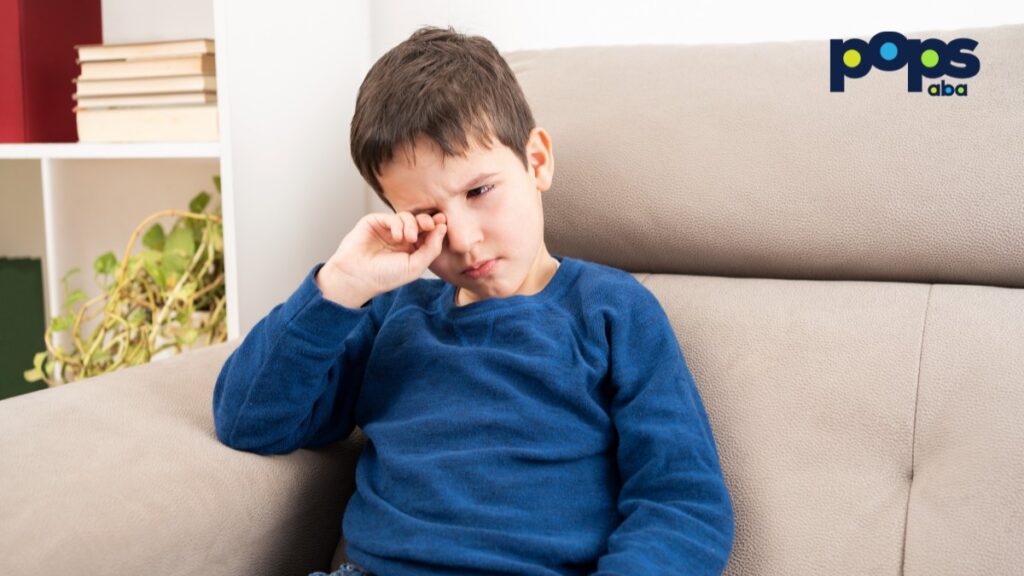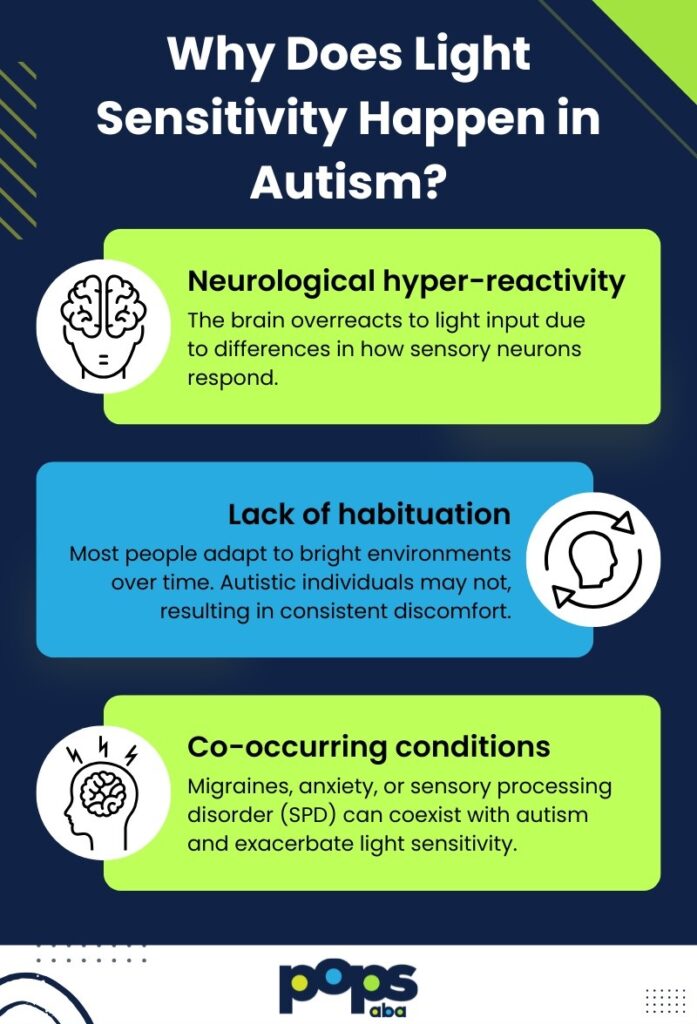Key Points:
- Light sensitivity is a common sensory processing issue in individuals with autism and often ties into broader neurological differences in sensory integration.
- Environmental triggers like fluorescent lights, screen glare, and overly bright spaces can significantly impact behavior and daily functioning.
- Practical solutions like light filters, behavioral strategies, and targeted ABA therapy can help manage and reduce sensitivity over time.
You’ve probably noticed it—your child shielding their eyes, turning off lights, or melting down in brightly lit spaces. Naturally, you start to wonder: does autism cause light sensitivity? It’s a question many parents ask, and the answer holds real insight into how your child experiences the world.

Does Autism Cause Light Sensitivity?
Yes, autism can cause light sensitivity. Many individuals on the autism spectrum experience sensory processing challenges, and light sensitivity (also called photophobia or visual hypersensitivity) is a common one. It can lead to discomfort, headaches, eye strain, or emotional distress when exposed to certain types or intensities of light.
What Is Light Sensitivity in Autism?
Understanding the link between autism and light sensitivity starts with recognizing how differently the brain processes sensory input. Individuals on the autism spectrum often experience heightened sensitivity—or sometimes under-sensitivity—to things like touch, sound, or light. In this case, bright lights, flickering screens, or harsh lighting can be more than annoying—they can be overwhelming or even painful.
For some, it’s the overhead fluorescent lights at school. For others, it’s the glare from a tablet or sunlight pouring through a window. These triggers can result in squinting, covering the eyes, behavioral meltdowns, or even avoiding certain spaces altogether. When parents first start noticing these patterns, the question “does autism cause light sensitivity?” becomes more than curiosity—it becomes a key to understanding their child better.
Why Does Light Sensitivity Happen in Autism?
Not all sensory sensitivities are created equal, and the same is true for light. So what’s really going on in the brain? Research suggests that neurological differences in how visual input is processed may be at the root of the issue.
The autistic brain often struggles with filtering sensory input. Where a neurotypical person’s brain might “dampen” overwhelming input, a person with autism may register all incoming sensory data at full volume—making it harder to filter out what’s necessary or tolerable.
Here’s a more detailed breakdown of potential causes:

What Are the Signs of Light Sensitivity in Autistic Children?
If you’re wondering whether your child’s reaction to lighting is related to autism, there are several telltale signs to watch for. While not every child will react the same way, certain behaviors tend to crop up frequently.
These signs usually show up in environments with harsh lighting or screen exposure. Here’s what you might notice:
- Covering eyes or wearing sunglasses indoors
- Avoiding brightly lit spaces
- Complaining about headaches or eye pain
- Frequent blinking, squinting, or looking down
- Meltdowns or irritability when entering lit environments
- A preference for dim or natural lighting
Some children may not verbalize the discomfort, but their body language and behavior can offer clues. Light sensitivity often coexists with other sensory issues, such as sound sensitivity or tactile defensiveness.
What Kinds of Light Trigger Sensitivity?
Different types of lighting can also affect autistic individuals in different ways. For some, it’s all bright light. For others, it’s specific patterns or flickering that set off discomfort. So, before making any changes to your child’s environment, it’s helpful to identify what exactly is triggering the sensitivity.
The most common culprits include:
- Fluorescent lights – Their subtle flickering, often imperceptible to neurotypical individuals, can be intensely aggravating.
- LEDs and screen glare – Devices like tablets, smartphones, or even digital whiteboards can cause eye strain.
- Natural sunlight – Too much brightness, glare from windows, or sunlight reflecting off surfaces can be overwhelming.
- High-contrast environments – Places with extreme lighting changes, like moving from a dark room to a bright one.
By narrowing down what’s causing discomfort, parents and educators can create safer, more supportive environments.
How Can Parents Help Manage Light Sensitivity at Home?
The good news is, there are plenty of ways to adapt your home to minimize light sensitivity triggers. You don’t need to turn your living room into a sensory deprivation chamber—just a few intentional changes can go a long way.
Here’s how you can start creating a light-friendly environment:
- Use natural light strategically – Let in natural light, but use sheer curtains to diffuse it.
- Install dimmable lights – Give your child more control over brightness levels.
- Avoid overhead fluorescent lights – Use floor or desk lamps with warm-toned bulbs instead.
- Add filters or covers – Use colored lens covers for lights to soften their glare.
- Create “low-sensory zones” – Designate a quiet, dim area where your child can retreat when overstimulated.
Trial and error is part of the process. It’s okay if the first change doesn’t fix everything. The key is observing, adjusting, and repeating based on your child’s unique needs.
How Does ABA Therapy Help With Sensory Challenges Like Light Sensitivity?
Applied Behavior Analysis (ABA) therapy isn’t just for managing behavior—it’s about understanding why behaviors happen and teaching adaptive alternatives. When it comes to light sensitivity, ABA can be incredibly valuable.
Here’s why it works:
- Data-driven understanding – ABA therapists can track triggers, responses, and progress over time.
- Personalized plans – Therapy is tailored to the child’s unique sensory profile and behavioral goals.
- Coping skills training – ABA can help children recognize their discomfort and communicate it in safe, healthy ways.
- Environmental shaping – Therapists can guide parents in adapting home or school settings to reduce distress.
ABA doesn’t aim to “fix” sensitivity—it focuses on building independence, emotional regulation, and the ability to self-advocate. That’s a huge win for both kids and parents.
ABA Therapy in New Jersey and North Carolina: Real Support for Sensory Challenges
Light sensitivity may feel overwhelming—especially when it disrupts everyday routines—but the right support can make all the difference. At Pops ABA, we specialize in helping children with autism navigate the sensory world with confidence. Our ABA therapy programs aren’t one-size-fits-all. They’re built around each child’s strengths, challenges, and goals.
Whether your child is dealing with light sensitivity, emotional regulation, or behavioral delays, ABA therapy can provide a structured, compassionate path forward.
We proudly offer ABA therapy services in North Carolina and New Jersey, connecting families to evidence-based care that meets their child where they are—and helps them grow from there.
Let’s make the world a little more comfortable, one light at a time.



